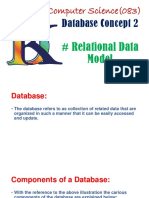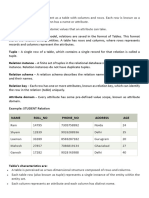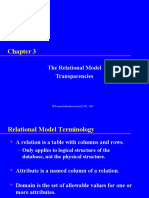0% found this document useful (0 votes)
45 views9 pagesDBMS U2
The document provides an overview of the relational database model, detailing its structure, key terms, and the importance of keys for data integrity and efficient retrieval. It explains the logical view of data, emphasizing data independence and relationships, and outlines various types of keys, including primary, foreign, and composite keys. Additionally, it discusses integrity rules that ensure data quality, security, and consistency within a database management system.
Uploaded by
priya sathishkumarCopyright
© © All Rights Reserved
We take content rights seriously. If you suspect this is your content, claim it here.
Available Formats
Download as PDF, TXT or read online on Scribd
0% found this document useful (0 votes)
45 views9 pagesDBMS U2
The document provides an overview of the relational database model, detailing its structure, key terms, and the importance of keys for data integrity and efficient retrieval. It explains the logical view of data, emphasizing data independence and relationships, and outlines various types of keys, including primary, foreign, and composite keys. Additionally, it discusses integrity rules that ensure data quality, security, and consistency within a database management system.
Uploaded by
priya sathishkumarCopyright
© © All Rights Reserved
We take content rights seriously. If you suspect this is your content, claim it here.
Available Formats
Download as PDF, TXT or read online on Scribd
/ 9























































































